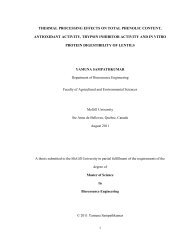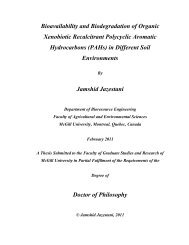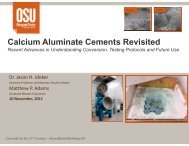Postharvest treatments to reduce chilling injury symptoms in stored ...
Postharvest treatments to reduce chilling injury symptoms in stored ...
Postharvest treatments to reduce chilling injury symptoms in stored ...
You also want an ePaper? Increase the reach of your titles
YUMPU automatically turns print PDFs into web optimized ePapers that Google loves.
ipen quickly once harvested. As with most fruits, it is possible <strong>to</strong> slowdown the ripen<strong>in</strong>g<br />
process and extends the s<strong>to</strong>rage life by reduc<strong>in</strong>g the temperature of the fruits. However,<br />
like many other tropical and subtropic al fruits, mangoes are prone <strong>to</strong> <strong>chill<strong>in</strong>g</strong> <strong>in</strong>juries<br />
when s<strong>to</strong>red below critical m<strong>in</strong>imum temperature (Chapl<strong>in</strong> et al., 1991; Lizada, 1991).<br />
Recommended s<strong>to</strong>rage temperatures are generally with<strong>in</strong> the range of 10 <strong>to</strong> 15 ºC<br />
and lead <strong>to</strong> s<strong>to</strong>rage life after harvest of 2 <strong>to</strong> 3 weeks. Longer s<strong>to</strong>rage life could be<br />
achieved if the resistance of mangoes <strong>to</strong> low temperature could be improved. This would<br />
allow more fruits <strong>to</strong> be shipped <strong>to</strong> overseas’ markets.<br />
3.2.1 Chill<strong>in</strong>g <strong>in</strong>juries<br />
Mangoes exposed <strong>to</strong> temperatures below the critical m<strong>in</strong>imum temperature<br />
develop severe physiological disorders referred <strong>to</strong> as <strong>chill<strong>in</strong>g</strong> <strong><strong>in</strong>jury</strong> (CI) symp<strong>to</strong>ms. The<br />
primary cause of CI is <strong>to</strong> damage the cell membrane that <strong>in</strong>itiates a cascade of secondary<br />
reactions. CI is a time-temperature problem and some cultivars are more sensitive than<br />
others (Mann and S<strong>in</strong>gh, 1976; Farooqui et al., 1985; Fornaris-Rullan et al., 1989; and<br />
Saucedo Veloz et al., 1977). CI symp<strong>to</strong>ms <strong>in</strong>clude: grayish scald-like discoloration of the<br />
sk<strong>in</strong>, sk<strong>in</strong> pitt<strong>in</strong>g, uneven ripen<strong>in</strong>g, reduction <strong>in</strong> the level of carotenoids, and poor aroma<br />
and flavor (Abou-Aziz et al., 1976; Hat<strong>to</strong>n et al., 1965; Thomas and Oke, 1983; Wardlaw<br />
and Leonard, 1936).<br />
3.2.2 Control of CI symp<strong>to</strong>ms<br />
<strong>Postharvest</strong> heat-<strong>treatments</strong>, plant growth regula<strong>to</strong>rs and antioxidants have been<br />
successfully used <strong>to</strong> alleviate CI symp<strong>to</strong>ms of tropical fruits. Moderate heat-<strong>treatments</strong><br />
<strong>reduce</strong> the <strong>in</strong>cidence of CI symp<strong>to</strong>ms <strong>in</strong> many tropical crops (Shellie and Mangan, 1994).<br />
Heat-<strong>treatments</strong> <strong>in</strong>duce heat shock prote<strong>in</strong> (HSP), which protected products from both<br />
heat <strong>in</strong>juries and CI. HSP also called stress prote<strong>in</strong>s, and are a group of prote<strong>in</strong>s that<br />
present <strong>in</strong> all cells <strong>in</strong> all life forms. They are <strong>in</strong>duced when a cell undergoes various types<br />
of environmental stresses like heat, cold and oxygen deprivation (Woolf et al., 1995;<br />
Kle<strong>in</strong> and Lurie, 1991). The desired temperature and duration of the treatment is product-<br />
dependent and its efficacy varies from product <strong>to</strong> product. The treatment is best applied<br />
by immersion <strong>in</strong> a temperature controlled hot water (HW) bath. High temperatures affect<br />
29









